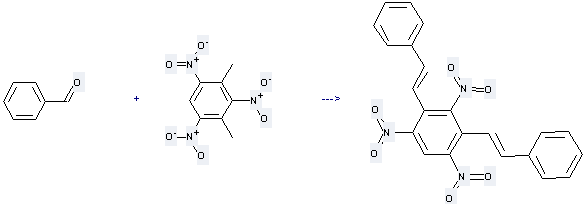-
Name
2,4,6-Trinitroxylene
- EINECS 211-187-5
- CAS No. 632-92-8
- Article Data24
- CAS DataBase
- Density 1.531 g/cm3
- Solubility
- Melting Point 184°C
- Formula C8H7N3O6
- Boiling Point 352.8 °C at 760 mmHg
- Molecular Weight 241.16
- Flash Point 170.2 °C
- Transport Information
- Appearance
- Safety 35
- Risk Codes 2-20/21/22-33
-
Molecular Structure
-
Hazard Symbols
 E,
E,  Xn
Xn
- Synonyms m-Xylene,2,4,6-trinitro- (6CI,7CI,8CI);1,3-Dimethyl-2,4,6-trinitrobenzene;2,4,6-Trinitro-m-xylene;2,4,6-Trinitroxylene;2,4-Dimethyl-1,3,5-trinitrobenzene;NSC 36975;NSC 405215;
- PSA 137.46000
- LogP 3.59760
Benzene,2,4-dimethyl-1,3,5-trinitro- Specification
The Benzene, 2, 4-dimethyl-1, 3, 5-trinitro-, with the CAS registry number 632-92-8, is also known as m-Xylene, 2,4,6-trinitro-. And its EINECS registry number is 211-187-5. This chemical's molecular formula is C8H7N3O6 and molecular weight is 241.15768. What's more, its IUPAC name is 2, 4-dimethyl-1, 3, 5-trinitrobenzene.
Physical properties about Benzene, 2, 4-dimethyl-1, 3, 5-trinitro- are: (1)ACD/LogP: 2.14; (2)# of Rule of 5 Violations: 0; (3)ACD/LogD (pH 5.5): 2.14; (4)ACD/LogD (pH 7.4): 2.14; (5)#H bond acceptors: 9; (6)#H bond donors: 0; (7)#Freely Rotating Bonds: 3; (8)Polar Surface Area: 137.46 Å2; (9)Index of Refraction: 1.622; (10)Molar Refractivity: 55.53 cm3; (11)Molar Volume: 157.5 cm3; (12)Polarizability: 22.01×10-24 cm3; (13)Surface Tension: 66 dyne/cm; (14)Density: 1.531 g/cm3; (15)Flash Point: 170.2 °C; (16)Enthalpy of Vaporization: 57.41 kJ/mol; (17)Boiling Point: 352.8 °C at 760 mmHg; (18)Vapour Pressure: 7.61E-05 mmHg at 25 °C.
Uses of Benzene, 2, 4-dimethyl-1, 3, 5-trinitro-: it is used to produce other chemicals. For example, it is used to produce trans-1, 3-Distyryl-2, 4, 6-trinitrobenzene by heating. The reaction needs reagent Piperidine and solvent Benzene. The reaction time is 15 hours. The yield is about 80 %.

When you are using this chemical, please be cautious about it as the following:
This chemical has risk of explosion by shock, friction, fire or other sources of ignition. And it has the danger of cumulative effects. In addition, this chemical is harmful by inhalation, in contact with skin and if swallowed. Besides, this material and its container must be disposed of in a safe way.
You can still convert the following datas into molecular structure:
(1) SMILES: Cc1c(cc(c(c1[N+](=O)[O-])C)[N+](=O)[O-])[N+](=O)[O-]
(2) InChI: InChI=1/C8H7N3O6/c1-4-6(9(12)13)3-7(10(14)15)5(2)8(4)11(16)17/h3H,1-2H3
(3) InChIKey: GGGVOOMKPJYWDF-UHFFFAOYAW
Related Products
- Benzene
- Benzene, (10-bromodecyl)-
- Benzene,1,1',1'',1'''-(oxydimethylidyne)tetrakis-
- Benzene,1,1',1'',1'''-silanetetrayltetrakis-
- Benzene,1,1',1'',1'''-silanetetrayltetrakis[4-methyl-
- Benzene,1,1'-[1,2-bis(methylene)-1,2-ethanediyl]bis-
- Benzene,1,1'-(1,2-cyclopropanediyl)bis-
- Benzene,1,1'-(1,2-ethanediyl)bis(2,4-dinitro-)
- Benzene,1,1'-(1,2-ethanediyl)bis[2-methyl-
- Benzene,1,1'-(1,2-ethanediyl)bis[4-methyl-
- 6329-50-6
- 63295-48-7
- 63295-51-2
- 6329-61-9
- 63296-46-8
- 6329-89-1
- 632-99-5
- 6329-99-3
- 6330-09-2
- 6330-12-7
Hot Products
About|Contact|Cas|Product Name|Molecular|Country|Encyclopedia
Message|New Cas|MSDS|Service|Advertisement|CAS DataBase|Article Data|Manufacturers | Chemical Catalog
©2008 LookChem.com,License: ICP
NO.:Zhejiang16009103
complaints:service@lookchem.com Desktop View